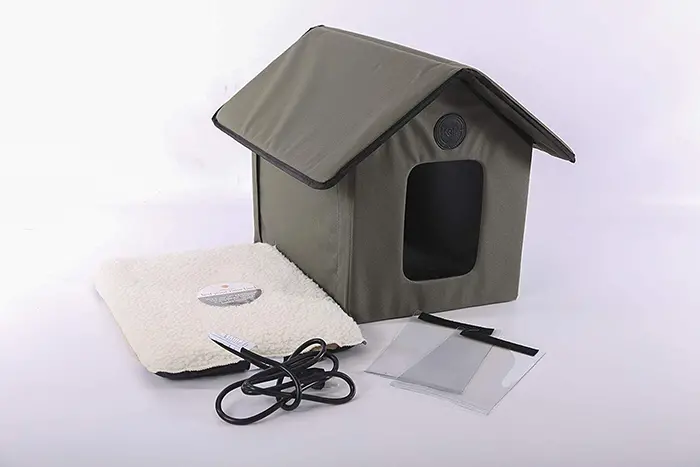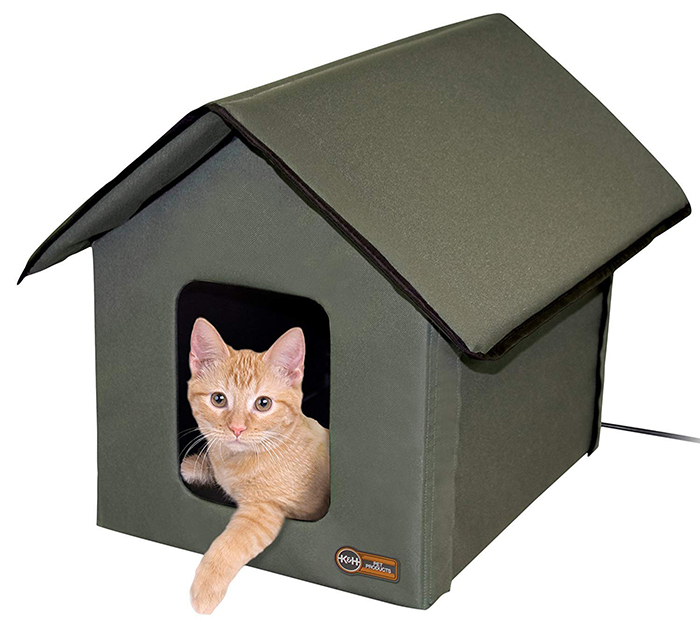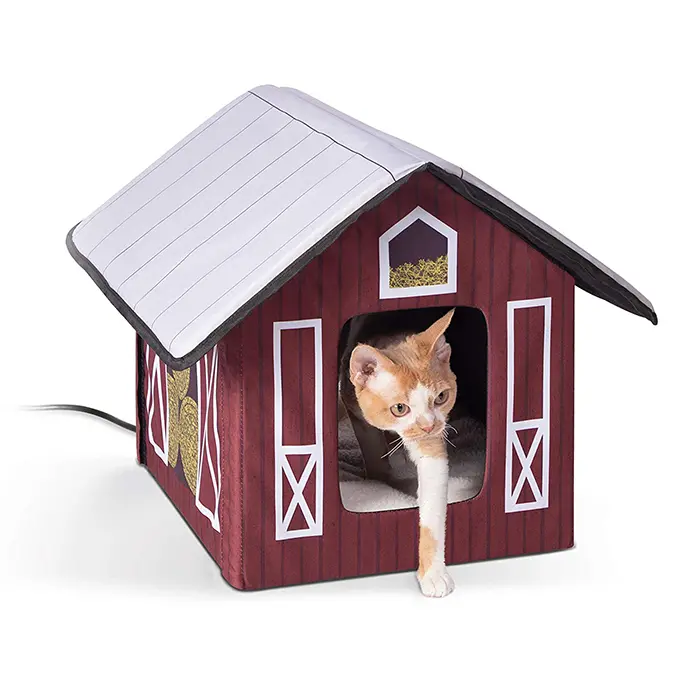Cats crave warmth—whether they’re curling up in a sunbeam, nestling on a fleece blanket, or burrowing into your lap. A heated cat house gives them a dedicated hideaway that retains heat, shields from drafts, and restores a sense of security. With this comprehensive guide, you’ll understand why these shelters matter, how they work, what features to look for, how to set them up safely, and whether they’re a smart match for your feline friend.
Table of Contents
Why Choose a Heated Cat House?

Cats Love Warmth—It’s an Instinct
Cats are descended from desert-dwelling species and carry a natural preference for cozy spaces. Their ideal resting body temperature is around 102–103°F (38.9–39.4°C), and when that’s not easily maintained—especially in cool climates—they seek artificial warmth.
Health Benefits for Seniors or Ailing Cats
Older cats or those with arthritis, joint pain, or chronic discomfort often find relief in heat. Studies have shown even low-level warmth helps stiff joints and soothes sore muscles.
Safety and Comfort for Outdoor or Feral Cats
A heated shelter isn’t just about luxury—it’s sometimes about survival. Outdoor cats, especially community or feral cats, face cold nights, rain, and wind. A well-designed heated cat house is both a refuge and a way to reduce hypothermia risk.
Better Sleep Leads to Healthier Cats
Consistent warmth improves sleeping quality, which supports immunity, behavior, and stress reduction. A dedicated house offers structure and a consistent sleeping routine.
Types of Heated Cat Houses
Indoor Heated Cat Houses
- Ideal for: Cats in unheated rooms, senior cats, or homes with inconsistent interior temperature.
- Design: Often soft-sided boxes with removable insulated panels and gentle thermostat-controlled pads.
- Benefits: Lightweight, quiet, portable, and great for cats that like enclosed space.
Outdoor Heated Cat Houses

- Ideal for: Stray or barn cats, porch cats, or homes where cats go outside during winter.
- Design: Waterproof exterior (plastic or treated wood), raised floors, weight-activated heating pads, insulation, and sometimes protective flaps or double walls.
- Benefits: Weather-resistant, provides safe indoor-style comfort outside.
Hybrid or Modular Units
- Some shelters allow the bottom portion to be brought indoors while leaving roof and sides outside. Others offer breakout panels or removable heat pads for cleaning or indoor storage.
How Heated Cat Houses Work
Understanding the technology inside helps ensure safety and performance:
Thermostatic, Weight-Activated Heating Pads
These pads stay off until a cat steps in. Once a cat’s weight is detected, a thermostat keeps the surface at a gentle, body-temperature level—typically 90–102°F. This prevents overheating, saves energy, and ensures the pad isn’t a constant hot plate.
Deep Insulation Retains Warmth
Layered foam or reflective insulation helps the shelter maintain a temperature advantage over outside. Well-designed models hold internal warmth 20–30°F above external air even without power.
Ventilation Allows Moisture to Escape
Tiny vents or breathable fabric panels let moisture and condensation wick away, reducing mold and body odor while maintaining air quality.
Multiple Entry and Exit Opens
Outdoors especially, a cat may need more than one escape route. Shelters with two or three openings give cats options to flee threats or enter without awkward turning.

Key Features to Look For
When deciding on or building a heated cat house, consider the following checklist:
- Weight-Activated Thermostat: ensures the pad heats only when needed.
- Low-Voltage Power Source: most pads run under 12 volts for safety.
- Raised, Non‑Slip Floor: keeps interior dry and reduces draft.
- Weatherproof Construction (Outdoor Models): includes waterproof roof and sealed seams.
- Balanced Insulation: foam or reflective lining, never bulky pillows that trap moisture.
- Multiple Entrances: for comfort and emergency exit.
- Low‑Voltage GFCI Ground-Fault Protection: for outdoor power use.
- Removable Bedding or Liners: easy to clean and maintain hygiene.
- Chew-Resistant Cord Covers: especially if outdoor cats might investigate or pets may gnaw.
- Proper Sizing: at least big enough for cat to turn around comfortably, but not large enough to lose heat quickly.
How to Choose the Right Heated Cat House
Consider Your Climate
- Cold winter areas (below 45°F): look for fully insulated outdoor designs with thick insulating walls.
- Mild winters or indoor use: simple heated beds may be sufficient.
Think About Your Cat’s Lifestyle
- Predominantly indoors but likes sleeping in cold lofts? Indoor heated shelters provide flexibility.
- Feral or community cats without access to climate control? A durable overnight house with pad and flap is ideal.
Material Preferences
- Plastic Shells: easy to clean, waterproof, durable.
- Wood or Composite: breathable, eco-friendly but may require weather seal or maintenance.
- Fabric Tents: lightweight and portable, though less robust outdoors.
Energy Efficiency Needs
- Use insulated pads or houses with auto-off.
- Consider solar-powered chargers or solar/refillable battery setups if outlets aren’t available.
Ease of Cleaning
- Detachable pads, removable liners, and wide doors simplify cleaning. This matters when sheltering multiple cats or dealing with wet seasons.
Step-by-Step: Setting Up a Heated Cat House

1. Select a Good Location
- Indoor: off cold floors (like concrete), away from drafts, ideally near a wall.
- Outdoor: under a porch or eave, sheltered from rain, and raised above the ground.
2. Elevate the House
Place bricks, wooden planks, or a specialized stand beneath to keep the floor above dampness and concrete.
3. Install Insulation
Line the interior walls and floor with foam board or reflective Mylar. Avoid loose-texture materials that collect moisture.
4. Position the Heating Pad
Put the thermostat pad flat on the floor, ideally in the deepest part. If it includes a weight sensor, position so that any cat resting inside triggers it. Cover pad with a washable fleece liner or thin blanket.
5. Add Bedding
- Indoor: light fleece or pet bed.
- Outdoor: use straw (not hay or blankets). Straw resists moisture, doesn’t rot, and provides thermal insulation.
6. Test Temperature
Place a heavy pillow or soft weight and let the pad run for 20 minutes. It should feel gently warm—not hot to the human touch.
7. Check Power Safety
All wiring should be weatherproof, GFCI protected outside, and away from rain splash. Use cord protectors or bury cords carefully.
8. Introduce the Cat
Place treats inside, leave the flap open, and allow your cat to explore at its own pace. Avoid forcing entry.
Real Owner Experiences: Making It Work
Many cat caregivers share stories of heated shelters being transformative:
- Improved Joint Mobility: Cats with mobility issues became more active after years of stiffness.
- Higher Overnight Survival Rates: Shelters used for feral cats in winter accounted for colder nights without risks.
- Less Stress Behavior: Cats who had a consistent warm place showed fewer hiding, growling, or vocalization issues when weather turned cold.
- Cleaner Shelters: Owners who use straw bedding noticed much less dampness compared to blankets.
Who Benefits Most from a Heated Cat House?
- Senior and arthritic cats: warmth eases joint pain.
- Short-haired or underweight cats: less tolerance for cold.
- Outdoor or community cats: require weather shelter and heat.
- Kitten families: need reliable, safe warmth to thrive.
- Rescue or recovery cats: warmth speeds healing and reduces stress.
Potential Risks & How to Mitigate Them
Overheating
Cats instinctively move away from heat— but if the pad is too hot or the environment barely ventilated, they may not escape. Choose pads with thermostats, and regularly touch-test the surfaces.
Electrical Hazards
Ensure all wiring is chew-proof and rated for outdoor use when applicable. GFCI outlets and regular inspections help prevent shocks or fire.
Mold & Mildew
Moisture buildup inside an insulated house can lead to mold. Using vents, straw bedding, and non-absorbent liners can prevent this. Check often if the house is in sunlight or near moisture.
Escape Risk
If your cat panics inside (due to another cat, a predator, or loud noise), a single-door house could trap it. Multi-entry designs are safer.
Maintaining a Heated Cat House for Longevity
- Inspect weekly for pad wear, wire damage, or insulation gaps.
- Replace stray straw regularly, and freshen bedding.
- Clean interior surfaces monthly with a mild pet-safe cleaner.
- Rotate interior liners so wet fabric or dust gets washed.
- Test heating pad functionality each season, ensuring it still activates only when weight is sensed and heats to correct range.
DIY Heated Cat House: Build Your Own
Materials You’ll Need:
- Sturdy plastic bin or wooden box with lid.
- Insulation (foam boards or reflective Mylar).
- Low-voltage, weight-activated heating pad with thermostat.
- Fleece liner or washable furniture fabric.
- Straw for bedding (if outdoor).
- Tools: cutoff knife, sanding block, rope or zip ties for securing cords.
Construction Steps:
- Create entryway opening (6–8″ diameter).
- Line inside walls/floor with insulation.
- Mount heating pad on floor connected to thermostat.
- Cover pad with locker-inside fleece.
- Insert straw bedding around pad (outdoor).
- Secure wires and seal any exterior joints.
- Test warmth with pillow and run time limiter.
Pro Tips:
- Use a hinged roof or removable top for easy access.
- Create a flap (clear plastic or fabric) for entry.
- Add small rubber feet or legs for elevation.
Frequently Asked Questions
How long should a cat spend in a heated house?
Moderate sessions of 30–60 minutes are ideal at first. Cats should be able to leave on their own and retreat when warm.
Is it safe to leave the heating pad running 24/7?
Only if the pad is fully thermostatic and weight-activated. Otherwise, it’s better to limit runtime or choose models with automatic shut-off.
Can kittens use a heated cat house?
Yes, but only when supervised and with gentle heat settings. It provides essential warmth during early growth stages.
What bedding is best—straw, fleece, or towels?
- Straw for outdoor use: shedding and breathable.
- Fleece or fleece blankets indoors for softness, provided moisture is controlled.
- Avoid towels indoors—they hold moisture and can rot.
Can I use a heated bed inside the house rather than a pad?
Yes—low-voltage heated pet beds work well indoors if they are chew-safe and thermostatically controlled.
Final Thoughts
A heated cat house is more than a pet accessory—it’s a healing, comforting, and life-saving sanctuary for cats who need warmth, security, and peace. Whether you buy a premium insulated model or build your own, focus on safe heating, proper insulation, a dry location, and breathable airflow.
Give your feline companion the gift of warmth and protection; they’ll reward you with purring, tranquility, and trust.
Want any guidance about pet products learn more at our website.



